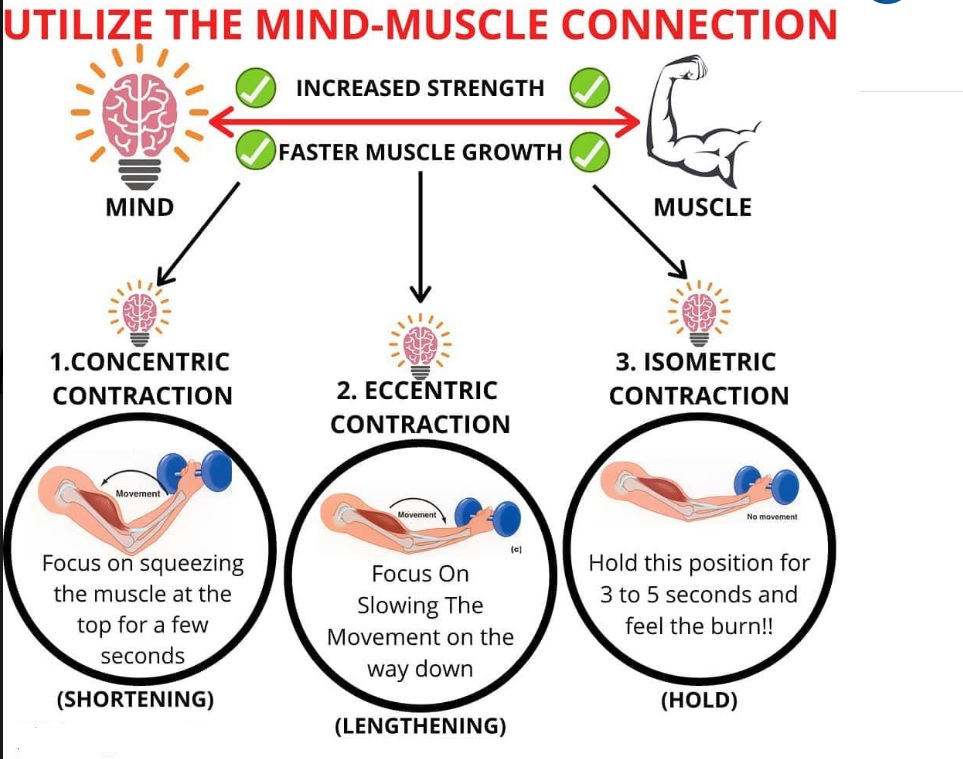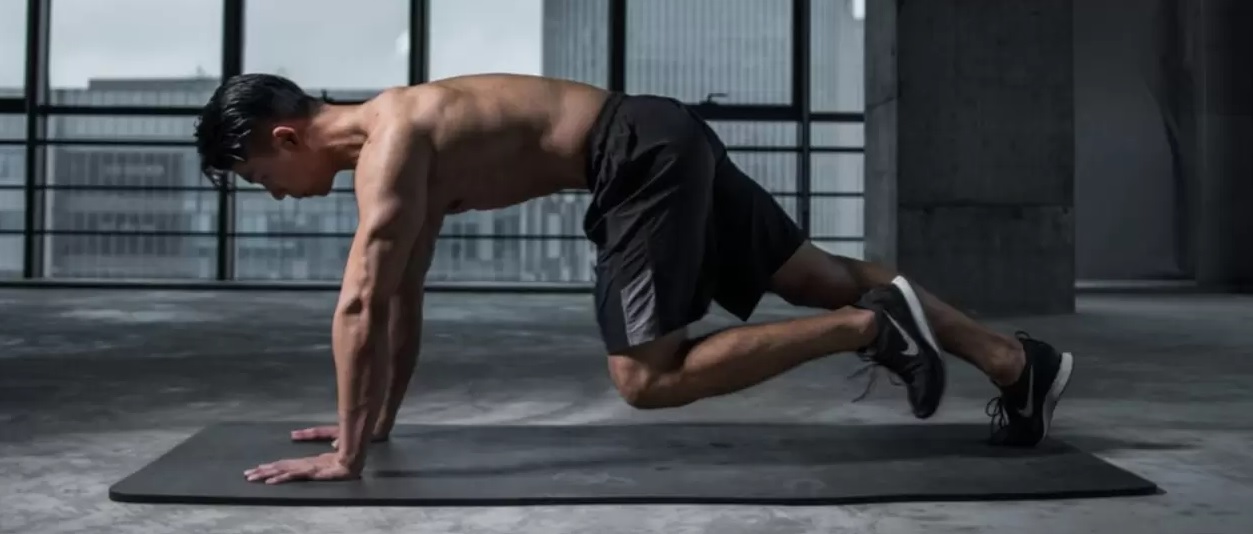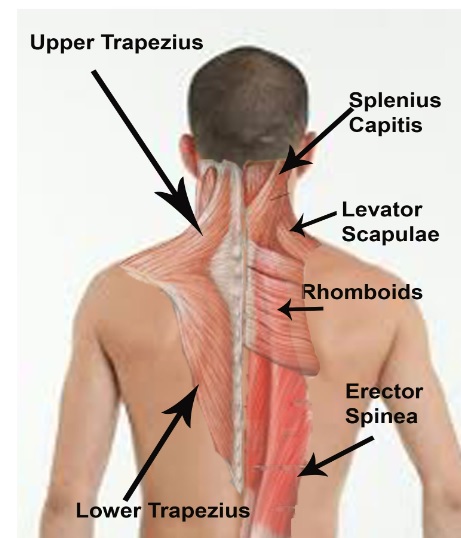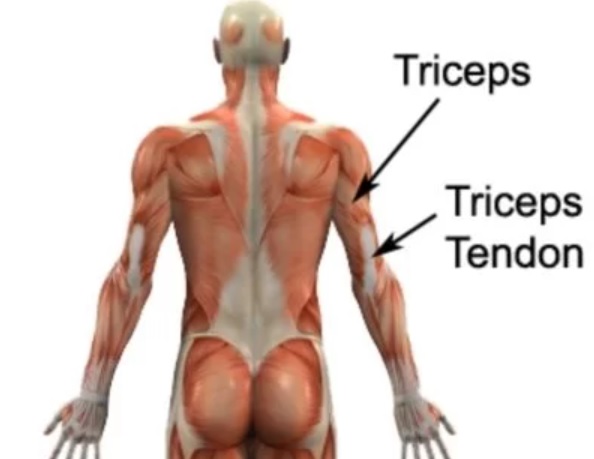- You know how you feel every muscle fiber when you’re really in the zone during a workout? That’s your mind-muscle connection at play.
- It’s not just about throwing weights around; it’s more about controlled, focused movements. Think quality over quantity. When lifting, for example, if you’re truly concentrating on each rep—feeling the contraction and stretch—you’ll reap greater benefits than just going through the motions.
- Getting bigger biceps isn’t simply a matter of doing curls until your arms ache—it involves visualizing and focusing on those specific muscles as they work hard with each lift.
- So don’t just go heavy or aim for endless reps; focus instead on connecting with each muscle movement mentally to unlock new gains physically. Like good food fuels our bodies before an intense gym session, having a strong mind-muscle link fuels a better workout by helping us tune into what we’re doing—and why it matters—for maximum results.

Why Mind-Muscle Connection Matters?
- Enhanced Muscle Engagement: Developing a strong mind-muscle connection allows you to isolate and activate the intended muscle groups with greater precision. This can help you maximize the benefits of your workouts by ensuring that you’re effectively targeting the muscles you want to work.
- Improved Muscle Recruitment: When you consciously focus on the muscle you’re working on, you recruit a larger number of muscle fibers within that muscle group. This results in more significant muscle contractions and, consequently, better strength and muscle-building outcomes.
- Reduced Compensation: Many people unknowingly compensate during exercises, relying on other muscle groups or body parts to complete movements. A strong mind-muscle connection helps you avoid compensation by ensuring that the primary muscle group is doing the work.
- Injury Prevention: Proper form is crucial for preventing injuries during exercise. The mind-muscle connection encourages you to maintain correct posture and alignment, reducing the risk of strain or injury.
- Increased Muscle Activation: Focusing on the muscle you’re working on can lead to more intense and productive workouts. You’ll feel a deeper burn and greater muscle engagement, which can be motivating and satisfying.
- Efficient Workouts: By ensuring that each repetition is purposeful and targeted, you make your workouts more efficient. This means you can achieve your fitness goals in less time.
Quick Workout Fixes
Step 1: Wake Up and Stabilize
- This step aims to prepare your body for exercise.
- Start with gentle neck stretches, moving your head from side to side and forward and backward. Perform shoulder rolls, moving them in circular motions, both forwards and backward. Finally, do some upper back stretches, such as pulling your arms across your chest or reaching your hands overhead.
- Doing these stretches gets rid of tightness and ramps up blood flow in your trap muscles, getting them ready for the workout that’s coming. Plus, they help you keep a good posture and give you more flexibility.

Step 2: Recruit Fibers
- Ensure that you’re using the correct muscles during your workout.
- Focus on using your mind-muscle connection. Visualize the specific shoulder muscles you want to target while performing your exercises. For example, during a shoulder press, concentrate on your deltoids and not your traps. Ensure proper form and posture to isolate the intended muscles.
- It’s all about knowing your body, right? So when you’re working those shoulders, make sure you’re consciously engaging the correct muscles. By zeroing in on your delts during exercises like shoulder presses, not only are we preventing injuries but also boosting that muscle performance.
Step 3: Increased Blood Flow
- Increased blood flow is the gateway to unlocking your muscle potential during a workout.
- It primes your muscles for action by delivering the oxygen, nutrients, and energy they need.
- Amping up your workout starts way before you hit those weights. Start with a solid warm-up and don’t forget to breathe. With all that oxygen-rich blood rushing in, your muscles will be ready to go.
- Laying this crucial foundation sets you up for workout success. You will be primed to sustain a healthy, injury-free exercise routine.
Common Mobility Issues in Workouts
Mobility issues in workouts refer to limitations in the range of motion and flexibility of your joints and muscles, which can hinder your ability to perform exercises effectively and safely. So, these mobility hiccups can mess with different parts of your body. They could come from various things like injuries, muscles not playing nice together, slouching all the time, or just not being stretchy enough. But remember to keep it professional – we’re talking fitness science here!
- Joint Mobility: Joint mobility refers to the ability of your joints to move freely through their full range of motion. Restrictions in joint mobility can be due to conditions like arthritis, joint inflammation, or previous injuries. Such an issue can create real roadblocks in your fitness routine, especially when you need to do overhead exercises. Think about the movements involved in a shoulder press or pull-ups – they all demand good shoulder flexibility and strength. So, it’s crucial to give some attention to improving joint mobility if we want not only our workouts but also our daily lives to be smoother and pain-free.
- Muscle Tightness: Muscle tightness is a common cause of mobility issues. Tight muscles can restrict your ability to move freely and can lead to poor posture and imbalances. Working out those stiff muscles with some stretching and mobility drills can help loosen things up. It’s like giving your body a tune-up so you’re not feeling all tight and restricted in your movements. Regular stretches and exercises are the keys to unlocking better mobility.
- Imbalances: Muscle imbalances occur when some muscles are stronger or more dominant than others. These imbalances can affect joint stability and lead to improper movement patterns. Fixing muscle imbalances is key, not just for moving around easily but also to avoid injuries. Let’s say you’ve got super strong quads but your hamstrings are lagging behind – that could affect the stability of your knee. A strong quadriceps muscle compared to weaker hamstrings can lead to knee instability.
- Poor Posture: Poor posture can contribute to mobility issues. It can lead to muscle imbalances, particularly in the neck, shoulders, and lower back. Getting your posture right with workouts and staying aware can boost how well you move around. Maintaining good posture isn’t just during gym time; make sure you’re not hunching over when reading textbooks or even chilling at home.
- Lack of Warm-Up: Skipping a proper warm-up before workouts can contribute to mobility issues. Cold muscles and joints are less flexible and more prone to injury. Getting your body ready for a workout is all about warming up. This means you gotta get the blood pumping, loosen those muscles and prepare yourself for workouts.
- Inadequate Recovery: Overtraining and insufficient recovery can also impact mobility. Continuous, high-intensity workouts without proper rest can lead to muscle tightness and reduced joint mobility.

What You Should Do Before Training
Chest Workouts:
- Lie on the bench and start retracting your scaps to ensure your lower traps are completing the movement, not the fibers in your upper traps. Supinate your palms as you contract up.
- If you want to quickly activate and connect with your chest muscles. Do two sets of 20 reps with focused effort.
For Muscle Engagement
- Moderate Weight: Using a moderate weight means you’re not lifting too heavy, allowing you to focus on controlled movements.
- 4-Count Reps: This refers to taking a total of 4 seconds to complete one repetition. You spend 2 seconds lifting the weight (concentric phase) and 2 seconds lowering it (eccentric phase). This method is not only effective but also ensures that every move counts towards your workout goal!
- 4-Count Isometric Hold: After lowering the weight, you hold it in a specific position for 4 seconds. An isometric hold means your muscles stay contracted without lengthening or shortening further.

Importance of this Technique
- Retraining Muscle Firing: This technique helps retrain your muscles on which ones should be active during the exercise. By moving slowly and holding at the bottom, you focus on engaging the intended muscles (in this case, likely the deltoids) instead of relying on other muscles. This approach is a real game changer for making your delts function properly.
- Strengthens Muscles at Extreme Range: Holding the weight at the bottom in an isometric hold challenges your muscles at their extreme end range of motion. This helps strengthen them in that position, which can be beneficial for preventing injuries. Stronger muscles are more resilient, and training them at their end range can improve joint stability and reduce the risk of strains or tears.
Shoulder Activation
- You can position your arms close to your body with a relaxed stance, gently moving them in a circular motion both forward and backward.
- This action promotes external rotation when your shoulders open up and extension as you retract them. This initial movement activates the muscles that will be involved. Following this, it’s important to swiftly prepare and condition your shoulders, enhancing both internal and external rotation.
- Sit down and place your foot on the bench, creating a position where you can press your elbow against your knee, thereby activating your serratus anterior muscles. Using light weights, accentuate the external rotation of your shoulder through muscle contractions.
- At the top of the movement, hold the position for a few seconds, and push the limit by trying to extend it further. Afterward, focus on the internal rotation of your shoulders.
- At the bottom of the movement, maintain the position for a few seconds, attempting to flex and push it even further downward.
- This exercise can be performed for ten repetitions on both sides, completing two sets in total.

Benefits:
- This exercise serves as an effective way to engage the lower trapezius and rhomboid muscles, which play a crucial role in maintaining shoulder stability, posture, and good form during various shoulder exercises. It also helps in warming up and preparing the shoulders for a workout.
- This exercise’s main aim is to level up your shoulder rotation, both internal and external. Think about it like this – you’re not just moving your shoulders; you’re tuning them up for more mobility and flexibility.
- This drill focuses on boosting the mobility, flexibility, and stability of your shoulder joints. It zeroes in on both internal and external rotation while those 3-second pauses at each extreme make sure every muscle is fully engaged for better control.
- This intense finisher ramps up the blood flow to your shoulder muscles, giving you a killer pump and connecting your mind to those muscles.
- This shoulder workout is all about waking up those muscles, getting them moving, and making sure they’re involved in your session.
Arms: Tricep Activation and Elbow Discomfort
- Purpose: Strengthen triceps and address elbow discomfort during tricep extensions.
- Tricep Extension Issue: If you feel discomfort mainly in your elbow during tricep extensions, try this quick fix.
- Exercise: Lay on the ground with a resistance band. Create tension with the band and use your offhand to press down on your elbow gently, changing the hand’s position to relieve elbow discomfort.

Legs: Ankle Mobility and Calf Activation
- Purpose: Improve ankle mobility and activate calf muscles effectively.
- Exercise 1: Seated Calf Raise: This exercise is versatile and beneficial for various leg workouts, including squats and stiff-leg deadlifts.
- Execution: Use moderate weight, and do one set of 4-4-4, meaning a four-count negative, a four-count hold at the bottom, and a four-count positive. Focus on actively driving your foot down to engage the anterior tibialis muscle.
- Exercise 2: Elevated Heels for Squats: Elevate your heels for squats to eliminate the need for ankle mobility.
- Execution: Extend your heels on a platform and perform squats with a 10-count negative, a 10-count hold at the bottom, and a 10-count positive for 10 reps. Feel the engagement progress from glutes to hamstrings to quads.









